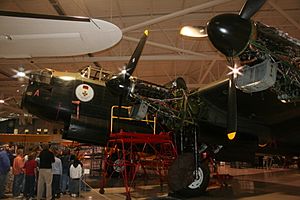Victory Aircraft facts for kids
| Industry | Aerospace |
|---|---|
| Fate | Sold to Hawker Siddeley Group |
| Successor | Avro Canada |
| Founded | 1942 |
| Defunct | 1945 |
| Headquarters | Canada |
|
Key people
|
J.P. Bickell, President |
| Products | Military aircraft |
Victory Aircraft Limited was a Canadian company that made airplanes during World War II. They mostly built planes designed in Britain, but they made them in Canada. This factory was like a "shadow factory." This means it was built far away from the war in Europe. This kept it safe from German attacks.
At first, a company called National Steel Car Ltd. was supposed to build the large Avro Lancaster bombers. They had a factory in Malton, Ontario, near where Toronto Pearson International Airport is today. National Steel Car was already making other planes. These included the Westland Lysander and parts for Hawker Hurricane fighters. They also made Avro Anson trainers and Handley Page Hampden bombers.
But there were questions about whether National Steel Car could handle such a big project. So, on November 4, 1942, the Canadian government took over the factory. They created a new company called Victory Aircraft Limited. This new company was a "Crown Corporation." This means it was owned and run by the government. J.P. Bickell, a businessman who worked for the government for free, became the president of Victory Aircraft Ltd.
Building Planes for War
The Malton factory was first planned to build the Martin B-26 Marauder bomber. But on September 18, 1941, it received a contract to build the Avro Lancaster Mk X heavy bomber instead. When the first drawings arrived in January 1942, the project seemed very difficult. Building one Lancaster plane involved about 500,000 steps. It also needed over 55,000 different parts. This did not even include the engines, turrets, or small items like rivets and bolts.
The Avro Lancaster X
In August 1942, a Lancaster Mk I plane (R5727) was flown from Britain to Canada. This plane was used as a "pattern" to help with production. The Canadian-built Lancasters were called the Mk X. They were slightly different from the British ones. Their engines, instruments, and radio equipment were made in Canada or the United States. The Rolls-Royce Merlin engines were the same design. But they were built by Packard in the United States.
Later, some Lancaster Mk X planes got a different middle-top gun turret. This new turret was made in the US. It was also moved to a new spot on the plane. All the main parts of the Canadian Lancasters could be swapped with British versions. This meant that if a plane was damaged, spare parts were easy to find.
At first, most parts were built at the Malton factory. But some parts, like bomb doors and flaps, were made by another company. Later, even more parts were made by other companies. For example, Canadian General Electric Co. Ltd. made the fuel tanks and tail parts. The outer wings were made by Fleet Aircraft Limited.
It took only 16 months from getting the first blueprints to the first test flight. This was a very impressive achievement. The number of workers at Malton grew from 3,300 in 1942 to 9,521 in 1944. Many of these workers were new to airplane building. About a quarter of them were women.
Almost exactly one year after the "pattern" plane arrived, the first Canadian-built Lancaster was ready. This plane, with serial number KB700, rolled off the assembly line on August 1, 1943. It was named the "Ruhr Express." There was a lot of excitement about its first flight and its trip to England. Even though it had some small issues, Canada was very proud to send its own Avro Lancaster to war.
Eventually, Victory Aircraft Ltd. built one Lancaster plane every day. After being flown to England, these Canadian "Lancs" joined No. 6 Group RCAF. This was the Canadian part of the British bomber force. This made it an "all-Canadian" effort in the war. The Lancaster X was also planned to be used by Canadian bomber squadrons. These squadrons would be part of the "Tiger Force" to bomb Japan. But the war with Japan ended before this force was sent overseas.
By the end of the war, the Malton plant had built a total of 3,629 Avro aircraft. This included 3,197 Ansons and 430 Mk X Lancasters. They also built six Avro Lancastrian transport planes. They even built one Mk XV Lincoln heavy bomber and a single York transport plane.
The End of Victory Aircraft
Victory Aircraft stopped working on November 11, 1945. In the same year, the Canadian government sold Victory Aircraft. It was bought by the Hawker Siddeley Group. This company then used the factory for its new branch, which became known as Avro Canada.
| Aircraft | What it was | Seats | First Flight | Number Built |
|---|---|---|---|---|
| Avro Anson | Twin-engined bomber/trainer | Crew of two | 1936 | 3197 |
| Avro Lancaster Mk X | Four-engined heavy bomber | Crew of seven | 1943 | 430 |
| Avro Lancastrian | Four-engined transport | Crew of five, nine passengers | 1943 | 6 |
| Avro Lincoln Mk. XV | Four-engined heavy bomber | Crew of seven | 1944 | 1 |
| Avro York C.1 (Special) | Four-engined transport | Crew of two, 24 passengers | 1942 | 1 |
See also


